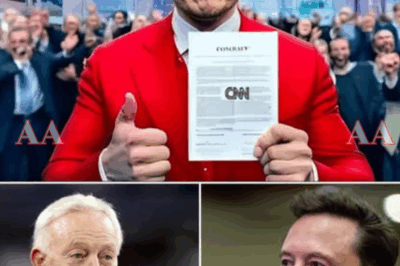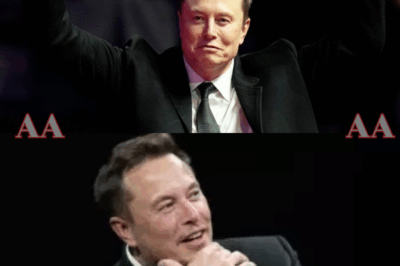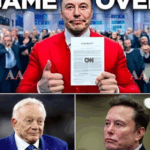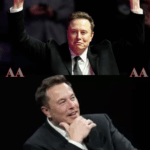In a surprising twist, Elon Musk has officially shut down Tesla’s ambitious DOJO supercomputer project—a move that has left many industry insiders and Tesla enthusiasts puzzled.
The decision comes just four years after DOJO was unveiled during Tesla AI Day in 2021, where it was hailed as a revolutionary supercomputer designed specifically for AI training.
Musk’s announcement has sparked widespread speculation about the reasons behind the abrupt cancellation and what it means for Tesla’s future in artificial intelligence.

The Birth of DOJO: A Bold Vision for AI Training
DOJO was introduced as a groundbreaking computing system that promised to redefine AI training.
Unlike conventional supercomputers, DOJO was designed to be superefficient, capable of performing massive amounts of AI training with minimal energy consumption.
Tesla envisioned DOJO as the backbone of its ambitious plans for self-driving cars and humanoid robots, both of which were announced alongside the supercomputer at Tesla AI Day.
The architecture of DOJO was unlike anything seen before. At its core was the D1 chip, Tesla’s first custom-designed AI chip, which consolidated the CPU, GPU, and RAM into a single piece of silicon—a design known as “system-on-a-chip” (SOC).
Each DOJO tile, about the size of a dinner plate, contained 25 D1 chips working in unison.
Multiple tiles could be stacked together to form a cabinet, creating the DOJO supercomputer cluster.
Tesla’s engineers touted DOJO’s unique design as a game-changer for AI training.
By reducing network latency and optimizing power efficiency, DOJO was expected to outperform traditional AI training systems powered by Nvidia GPUs.
However, despite the initial hype, DOJO never lived up to its lofty promises.
The Fall of DOJO: A Project Plagued by Setbacks

Fast forward to 2025, and the DOJO project is officially dead.
The downfall began with the departure of key personnel, including Ganesha, the architect behind the D1 chip and DOJO’s overall design.
Ganesha left Tesla in 2023 to start his own AI company, Destiny AI, taking with him several top engineers from the DOJO team.
His departure marked the beginning of a talent drain that Tesla struggled to recover from.
Further complicating matters, the DOJO project faced technical challenges that hindered its progress.
Despite Tesla’s claims of superior efficiency, DOJO failed to demonstrate significant advantages over Nvidia-powered systems.
Tesla’s existing AI training cluster, powered by Nvidia GPUs, continued to deliver reliable performance, raising questions about the necessity of DOJO.
In a leaked internal memo, Musk reportedly expressed frustration with the project’s lack of progress.
“DOJO was an experiment, and experiments don’t always work out,” Musk wrote.
“We need to focus our resources on proven technologies that drive real-world results.”
Elon Musk’s Bold Decision: A Strategic Pivot to AI6
Musk’s announcement to shut down DOJO was accompanied by a cryptic post on social media, where he hinted at Tesla’s next steps in AI development.
“Once it became clear that all paths converged to AI6, I had to shut down DOJO and make some tough personnel choices,” Musk wrote.
“DOJO 2 was now an evolutionary dead end. DOJO 3 arguably lives on in the form of a large number of AI6 SOCs on a single board.”
So, what is AI6? Tesla’s AI6 chip represents the next generation of in-car inference computing.
Unlike DOJO, which was designed for AI training, AI6 is optimized for real-time inference—allowing Tesla’s vehicles to process complex AI models locally without relying on external data centers.
This capability is critical for Tesla’s full self-driving (FSD) technology, which requires instantaneous decision-making to navigate roads safely.
Musk’s decision to scrap DOJO reflects a strategic shift in Tesla’s priorities.
By focusing on AI6 and other inference computing technologies, Tesla aims to enhance the performance of its vehicles while reducing costs associated with developing and maintaining custom AI training systems.
The Nvidia Factor: Why DOJO Was Doomed from the Start
One of the most compelling reasons behind DOJO’s cancellation is Tesla’s reliance on Nvidia GPUs for AI training.
Nvidia has emerged as the dominant player in the AI hardware market, supplying chips to nearly every major AI company, including Tesla.
Musk himself has become Nvidia’s largest customer, reportedly purchasing over a million GPUs for Tesla and his other ventures, such as XAI.
While DOJO was designed to compete with Nvidia, it never demonstrated a clear advantage.
Tesla’s existing AI training clusters, powered by Nvidia GPUs, continued to deliver robust performance, making DOJO redundant.
Moreover, Nvidia’s rapid advancements in GPU technology have made it increasingly difficult for competitors to catch up.
Musk’s decision to double down on Nvidia reflects a pragmatic approach to AI development.
“It doesn’t make sense for Tesla to divide its resources and scale two quite different AI chip designs,” Musk wrote in his post.
“The Tesla AI5, AI6, and subsequent chips will be excellent for inference and at least pretty good for training. All effort is focused on that.”
The Legacy of DOJO: Lessons Learned and Future Opportunities
While DOJO may be dead, its legacy lives on in Tesla’s AI strategy.
The supercomputer’s innovative architecture has provided valuable insights into chip design and system integration, which Tesla can apply to future projects.
Musk has hinted at the possibility of building a new supercomputer cluster based on DOJO’s design but using AI6 chips instead of D1 chips.
Meanwhile, Ganesha and his company, Destiny AI, are working on full-stack AI solutions that bear a striking resemblance to Tesla’s original vision for DOJO.
By developing chips, computers, data centers, and software for high-performance AI applications, Destiny AI is essentially rebuilding Tesla’s AI division outside the company.
This development raises intriguing questions about the competitive dynamics between Tesla and its former employees.
Tesla’s Roadmap: What’s Next for AI Development?
With DOJO out of the picture, Tesla is focusing its resources on inference computing and autonomous vehicle technology.
The upcoming AI5 chip, set to debut in 2026, promises significant performance improvements over the current AI4 chip.
Musk has described AI5 as a “game-changer” for FSD, paving the way for Tesla’s long-awaited robo-taxi fleet.
Beyond AI5, Tesla is already planning for AI6, which is expected to launch by 2028.
Musk has hinted that AI6 will deliver unprecedented capabilities, potentially enabling Tesla to achieve full Level 5 autonomy—a milestone that has eluded the company for years.
In addition to in-car computing, Tesla is expanding its AI training infrastructure with the Cortex supercomputer at Giga Texas.
Powered by Nvidia GPUs, Cortex is driving progress in FSD development and other AI applications.
Tesla is also planning a second-generation Cortex supercomputer, further solidifying its reliance on Nvidia.
Conclusion: A Strategic Gamble That Could Pay Off
Elon Musk’s decision to shut down DOJO marks a pivotal moment in Tesla’s AI journey.
While the supercomputer failed to deliver on its promises, its demise reflects Musk’s willingness to pivot when faced with challenges.
By focusing on inference computing and leveraging Nvidia’s proven technology, Tesla is positioning itself for long-term success in autonomous driving and AI development.
As Tesla continues to innovate, the lessons learned from DOJO will undoubtedly shape the company’s future projects.
Whether through AI6, Cortex, or other initiatives, Tesla remains committed to pushing the boundaries of what’s possible in artificial intelligence.
And while DOJO may be gone, its spirit lives on in the bold vision that defines Tesla’s approach to technology.
News
🚨 BREAKING: Just minutes ago, Elon Musk stunned the sports world by announcing he has officially purchased the Dallas Cowboys for a jaw-dropping $7.5 billion 🏈💰. In a shocking twist, longtime owner Jerry Jones revealed he will be stepping away — and even leaving the United States — after cashing out in what may be the most dramatic move in NFL history. Musk, already the mastermind behind Tesla and SpaceX, now adds “NFL franchise owner” to his empire. Fans are divided: some are hopeful that Musk’s bold vision could rescue the Cowboys from years of inconsistency, while others fear the billionaire’s experimental style could turn “America’s Team” into a risky venture. No matter which side you’re on, one thing is certain: the Cowboys will never be the same again. The future of the NFL just changed in real time — and the world is watching|KF
7 MINUTES AGO: Elon Musk Buys the Dallas Cowboys for $7.5 Billion — Jerry Jones Leaves America The sports world…
💥 “DISNEY CUT HIM. AGAIN. JIMMY KIMMEL’S RESPONSE? A CBS MEGA-DEAL, AN ON-AIR MIC DROP, AND A PROMISE THAT SHOOK THE INDUSTRY TO ITS CORE 💣🎤” The stage went dark. The audience held its breath. Then Jimmy Kimmel, no longer tied down by Disney’s restrictions, delivered a line so sharp it split the late-night world in two. Cameras rolled, jaws dropped, and by the end of his fiery outburst, one truth was clear: this wasn’t the end — it was a revolution. Insiders reveal CBS wasted no time, securing Kimmel in a mega-deal that has already sent rival networks scrambling. Rumors swirl of a “first show” unlike anything TV has ever seen — cryptic, daring, and set to dismantle the old rules of late-night. Executives are panicking, fans are buzzing, and competitors are wondering whose chair will be pulled out next. Jimmy didn’t just survive being cut. He turned rejection into a weapon — and now, the entire industry is bracing for impact. 🔥 The question isn’t whether late-night will change. It’s who will survive the new era Jimmy just ignited|KF
“Disney & ABC can kiss my ass!” That was Jimmy Kimmel’s explosive declaration after being fired — again — from ABC,…
🔥🚀 ELON MUSK SHATTERS ALL RECORDS — Forbes CONFIRMS He’s Now the First Human in History Worth $500 BILLION 💰⚡ From launching rockets into space to reshaping the future of transportation, Elon Musk has never played small. But this time, he’s crossed a line no one thought possible — becoming the first person on Earth to officially reach a staggering $500 billion net worth. 🌍 Fans call it proof of genius. Critics call it proof of greed. Either way, Musk’s meteoric rise is rewriting the rules of money, power, and influence. With Tesla, SpaceX, and xAI all fueling his empire, the question isn’t how high he can go — it’s whether anyone can ever catch up. But behind the headlines lies a bigger debate: Should so much wealth be concentrated in one man’s hands? And what does Musk plan to do with it — save humanity or dominate it? 👉 The story isn’t just about money. It’s about ambition, control, and the thin line between vision and obsession. The world is watching… and the countdown has only just begun|KF|KF
Synopsis Elon Musk’s net worth surged to $500 billion, making him the first person in history to reach this milestone….
💥 “$50 MILLION LAWSUIT SHOCKER — John Roberts Takes Jimmy Kimmel to Court After Explosive On-Air Meltdown” 💥 What started as a seemingly harmless late-night segment has spiraled into one of the biggest media scandals of the year. In front of millions of viewers, Jimmy Kimmel blindsided television veteran John Roberts with a brutal attack — calling out his integrity, his work, and the very system he represents. The audience gasped, the cameras kept rolling, and the fallout has been nothing short of explosive. Now, Roberts is striking back with a massive $50 million lawsuit, accusing Kimmel of defamation and on-air assault that went far beyond comedy. Industry insiders say this case could reshape how late-night television handles interviews, pushing the boundaries between satire and slander. Fans are divided: some call Kimmel’s outburst “necessary truth-telling,” while others brand it reckless and cruel. Roberts, however, has made it clear — he’s not just defending his name, he’s defending the principles of journalism itself. 🔥 The courtroom battle is set to be as dramatic as the clash that started it all — and the world is watching every move|KF
What began as a routine late-night interview quickly spiraled into one of the most shocking confrontations in television history. Jimmy Kimmel went…
End of content
No more pages to load












